Abstract
The files of the Oxford Record Linkage Study were used to identify 223 infants delivered to 168 epileptic women as the result of 218 pregnancies. There were six stillbirths, two of which were grossly malformed. It was shown that the population of epileptic mothers differed significantly from the total reproducing population in respect of social class. Each pregnancy resulting in a livebirth was therefore matched exactly for social class, civil status, maternal age, parity, hospital, and year of delivery with three control deliveries resulting in livebirths. The defects noted at birth were abstracted from the Record Linkage files, and any subsequent hospital admissions or deaths of the children were also abstracted.
There were highly significant excesses of congenital abnormalities among the infants born to epileptic mothers (13·8% of livebirths had some degree of defect of congenital origin compared with 5·6% of controls, P <0·0005). It was shown that neither the frequency with which the mother had fits nor the length of time she had had the epilepsy seemed to bear any relation to the frequency of defects in the offspring—with the exception of the two mothers who developed epilepsy in the first
Full text
PDF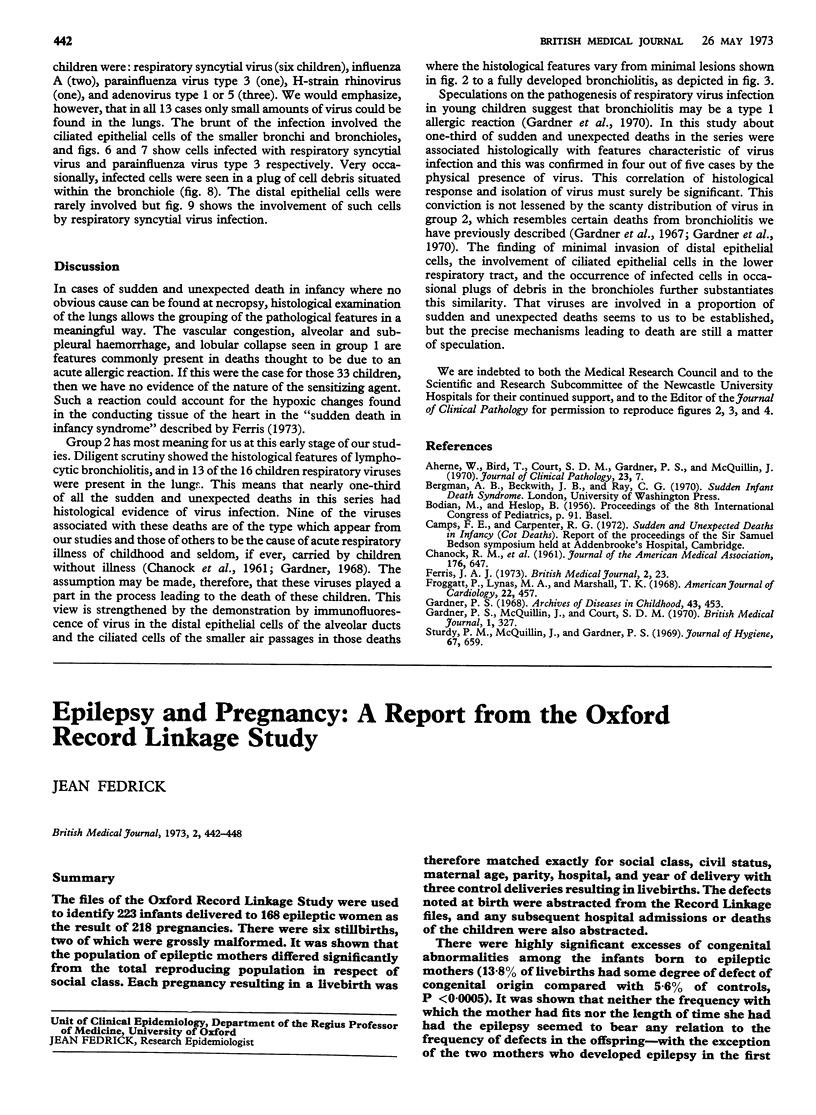
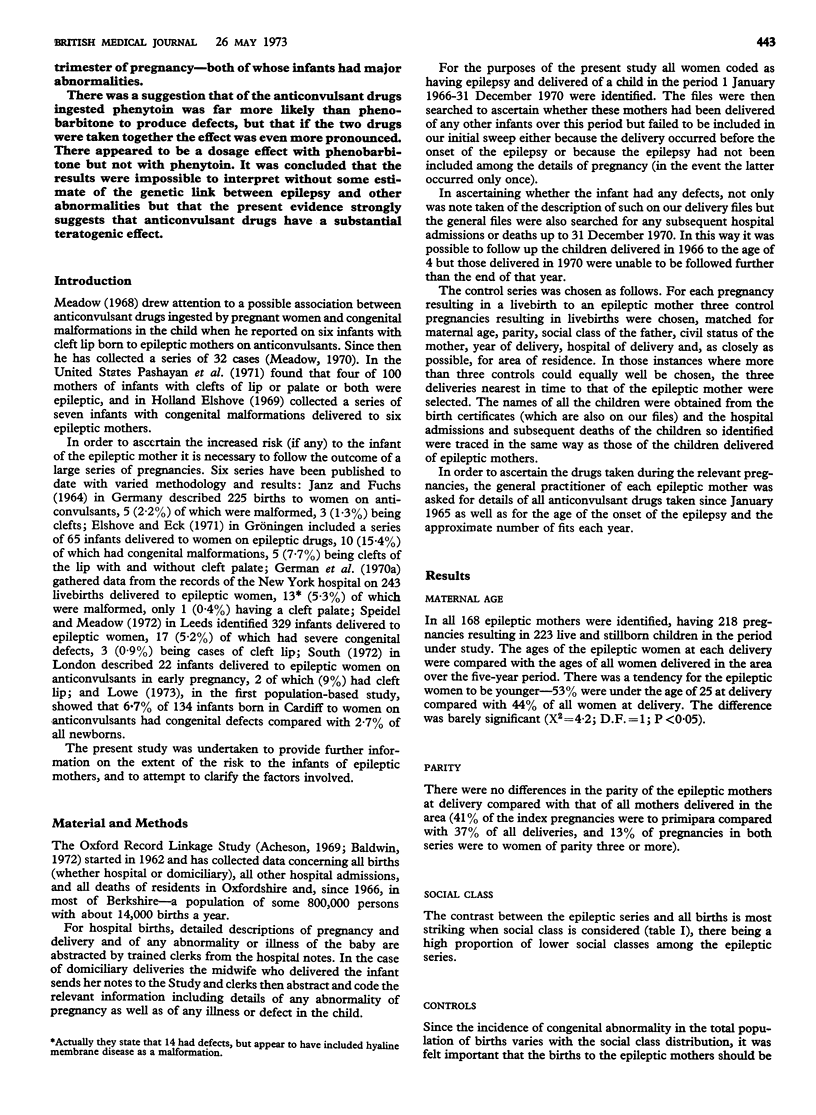
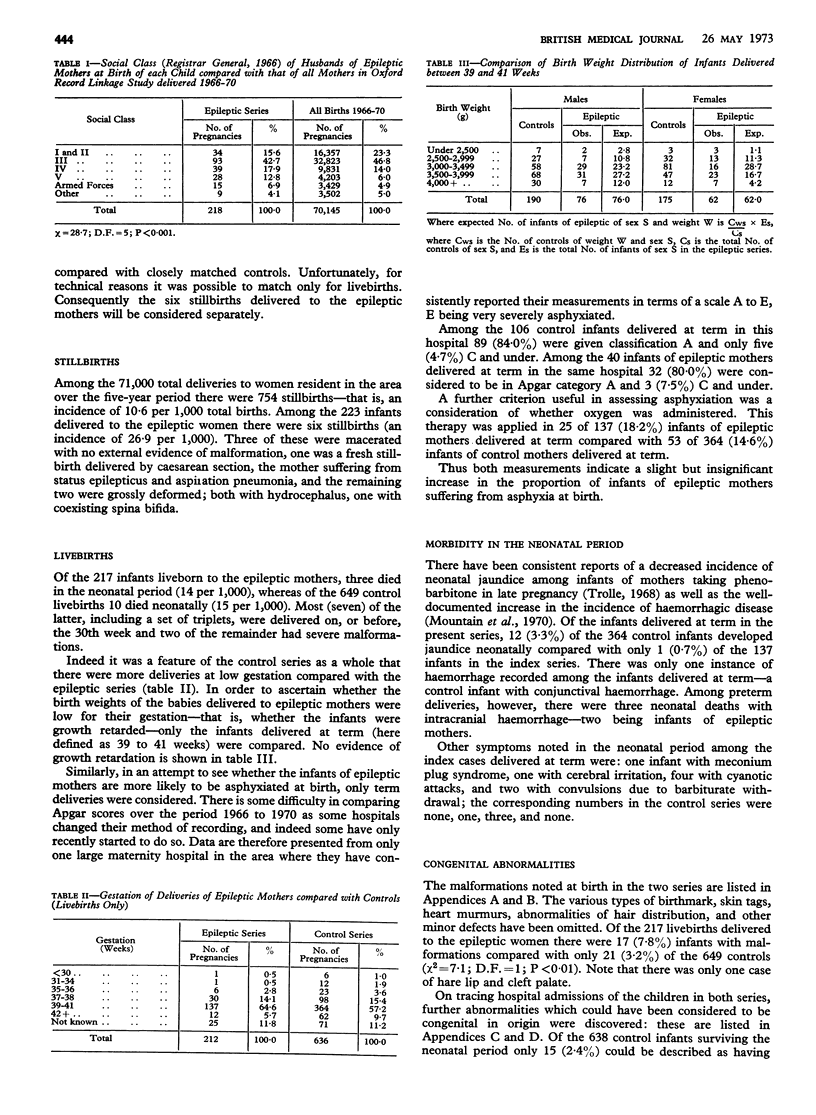
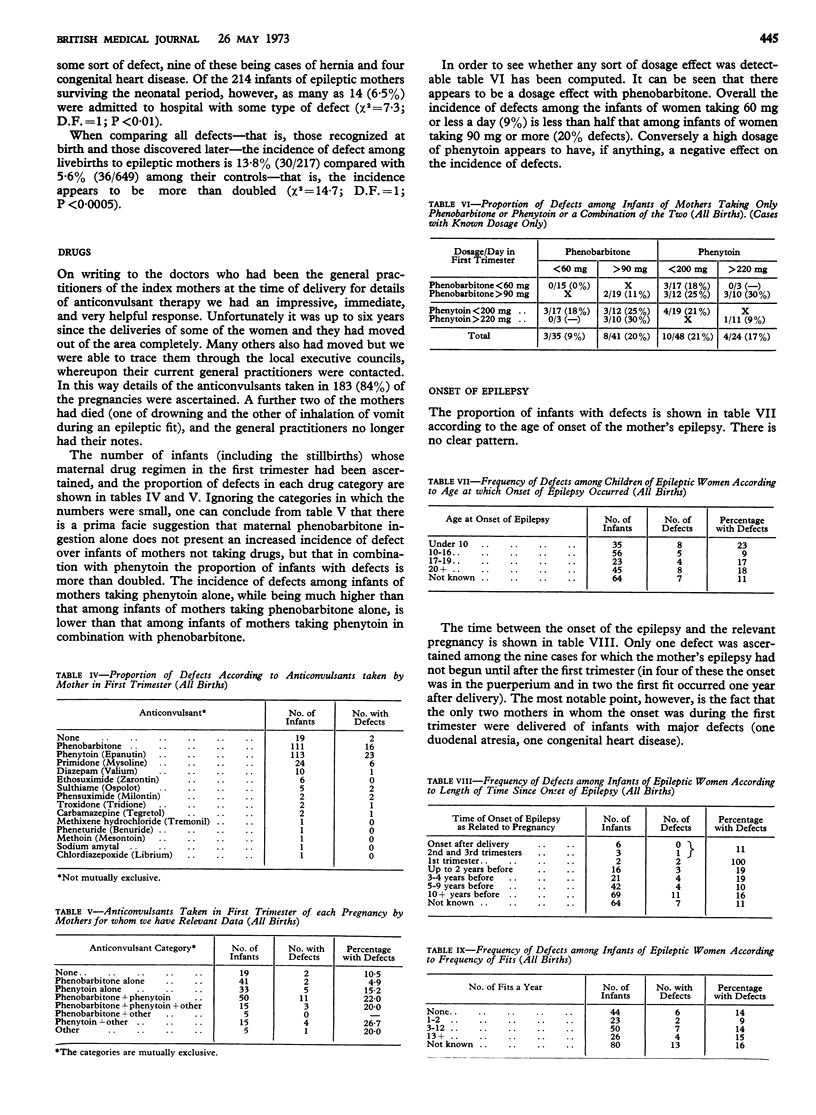

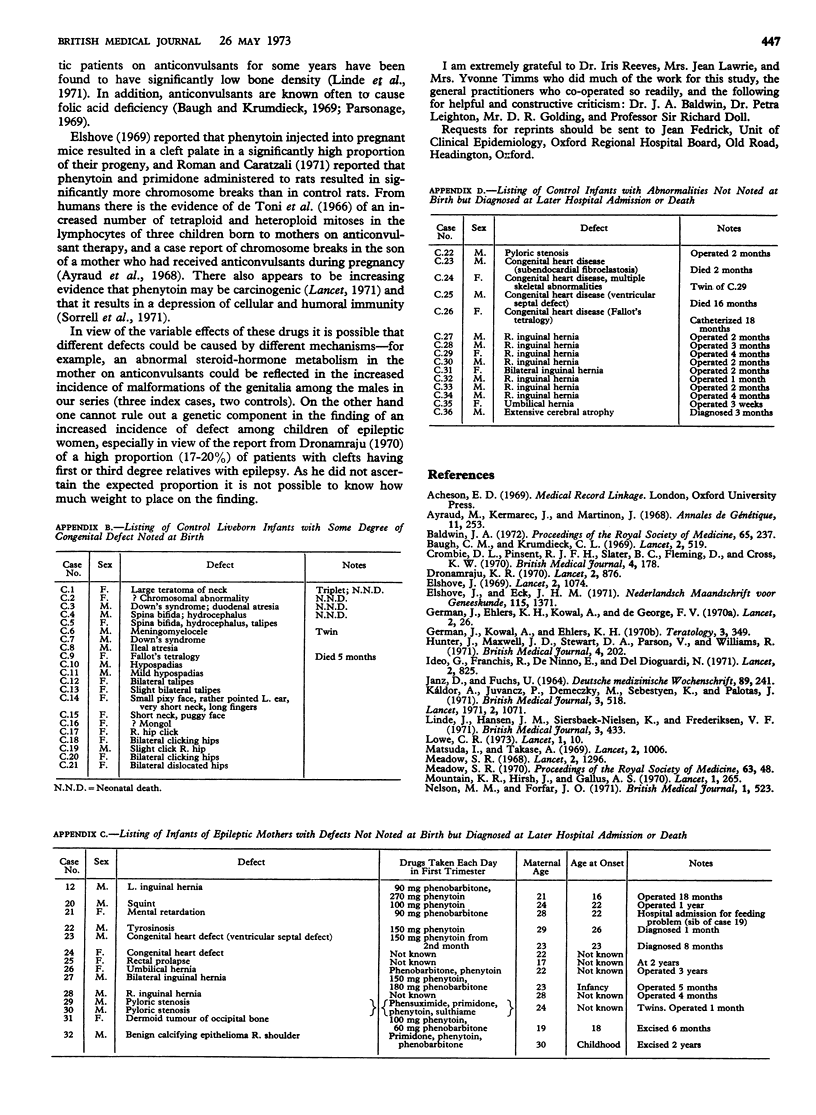
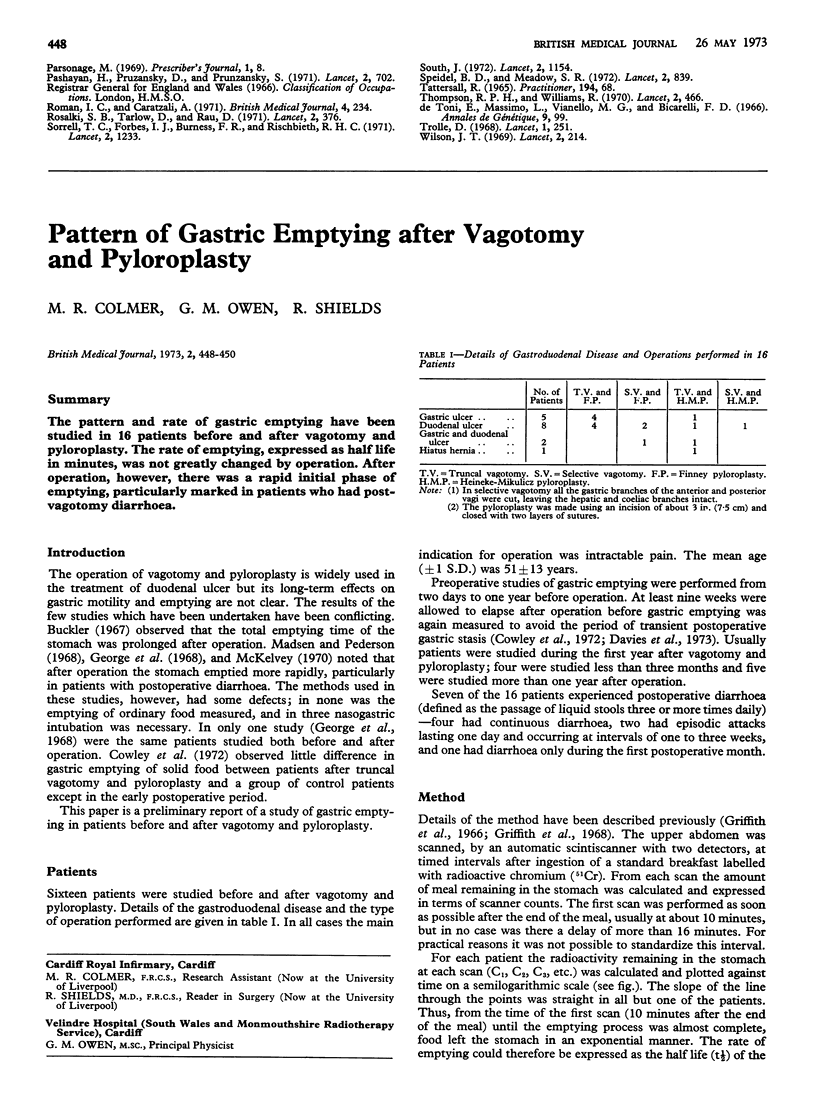
Selected References
These references are in PubMed. This may not be the complete list of references from this article.
- Arseneau J. C., Bagley C. M., Anderson T., Canellos G. P. Hyperkalaemia, a sequel to chemotherapy of Burkitt's lymphoma. Lancet. 1973 Jan 6;1(7793):10–14. doi: 10.1016/s0140-6736(73)91223-3. [DOI] [PubMed] [Google Scholar]
- Ayraud N., Kermarec J., Martinon J. Effets cytogénétique des médicaments anticonvulsants. A propos d'une observation d'anomalies transmises pendant la vie intra-utérine. Ann Genet. 1968 Dec;11(4):253–257. [PubMed] [Google Scholar]
- Baldwin J. A. The Oxford Record Linkage Study as a medical information system. Proc R Soc Med. 1972 Mar;65(3):237–239. [PMC free article] [PubMed] [Google Scholar]
- Baugh C. M., Krumdieck C. L. Effects of phenytoin on folic-acid conjugases in man. Lancet. 1969 Sep 6;2(7619):519–521. doi: 10.1016/s0140-6736(69)90218-9. [DOI] [PubMed] [Google Scholar]
- Crombie D. L., Pinsent R. J., Slater B. C., Fleming D., Cross K. W. Teratogenic drugs--R.C.G.P. survey. Br Med J. 1970 Oct 17;4(5728):178–179. doi: 10.1136/bmj.4.5728.178-c. [DOI] [PMC free article] [PubMed] [Google Scholar]
- Dronamraju K. R. Epilepsy and cleft lip and palate. Lancet. 1970 Oct 24;2(7678):876–877. doi: 10.1016/s0140-6736(70)92045-3. [DOI] [PubMed] [Google Scholar]
- Elshove J. Ceft palate in the offspring of female mice treated with phenytoin. Lancet. 1969 Nov 15;2(7629):1074–1074. doi: 10.1016/s0140-6736(69)90676-x. [DOI] [PubMed] [Google Scholar]
- Elshove J., van Eck J. H. Aangeboren misvormingen, met name gespleten lip met of zonder gespleten verhemelte, bij kinderen van moeders met epilepsie. Ned Tijdschr Geneeskd. 1971 Aug 14;115(33):1371–1375. [PubMed] [Google Scholar]
- German J., Kowal A., Ehlers K. H. Trimethadione and human teratogenesis. Teratology. 1970 Nov;3(4):349–362. doi: 10.1002/tera.1420030412. [DOI] [PubMed] [Google Scholar]
- Hunter J., Maxwell J. D., Stewart D. A., Parsons V., Williams R. Altered calcium metabolism in epileptic children on anticonvulsants. Br Med J. 1971 Oct 23;4(5781):202–204. doi: 10.1136/bmj.4.5781.202. [DOI] [PMC free article] [PubMed] [Google Scholar]
- Ideo G., De Franchis R., Del Ninno E., Dioguardi N. Phenobarbitone increases rat-liver gamma-glutamyl transpeptidase. Lancet. 1971 Oct 9;2(7728):825–826. doi: 10.1016/s0140-6736(71)92789-9. [DOI] [PubMed] [Google Scholar]
- JANZ D., FUCHS U. SIND ANTIEPILEPTISCHE MEDIKAMENTE WAEHREND DER SCHWANGERSCHAFT SCHAEDLICH? Dtsch Med Wochenschr. 1964 Feb 7;89:241–248. doi: 10.1055/s-0028-1111011. [DOI] [PubMed] [Google Scholar]
- Káldor A., Juvancz P., Demeczky M., Sebestyen K., Palotas J. Enhancement of methyldopa metabolism with barbiturate. Br Med J. 1971 Aug 26;3(5773):518–519. doi: 10.1136/bmj.3.5773.518. [DOI] [PMC free article] [PubMed] [Google Scholar]
- Linde J., Molholm Hansen J., Siersbaek-Nielsen K., Frederiksen V. F. Bone density and long-term anticonvulsant therapy. Br Med J. 1971 Aug 14;3(5771):433–433. doi: 10.1136/bmj.3.5771.433-a. [DOI] [PMC free article] [PubMed] [Google Scholar]
- Matsuda I., Takase A. Phenobarbitone treatment in haemolytic jaundice. Lancet. 1969 Nov 8;2(7628):1006–1006. doi: 10.1016/s0140-6736(69)90556-x. [DOI] [PubMed] [Google Scholar]
- Meadow S. R. Anticonvulsant drugs and congenital abnormalities. Lancet. 1968 Dec 14;2(7581):1296–1296. doi: 10.1016/s0140-6736(68)91781-9. [DOI] [PubMed] [Google Scholar]
- Meadow S. R. Congenital abnormalities and anticonvulsant drugs. Proc R Soc Med. 1970 Jan;63(1):48–49. [PMC free article] [PubMed] [Google Scholar]
- Mountain K. R., Hirsh J., Gallus A. S. Neonatal coagulation defect due to anticonvulsant drug treatment in pregnancy. Lancet. 1970 Feb 7;1(7641):265–268. doi: 10.1016/s0140-6736(70)90636-7. [DOI] [PubMed] [Google Scholar]
- Nelson M. M., Forfar J. O. Associations between drugs administered during pregnancy and congenital abnormalities of the fetus. Br Med J. 1971 Mar 6;1(5748):523–527. doi: 10.1136/bmj.1.5748.523. [DOI] [PMC free article] [PubMed] [Google Scholar]
- Pashayan H., Pruzansky D., Qruzansky S. Are anticonvulsants teratogenic? Lancet. 1971 Sep 25;2(7726):702–703. doi: 10.1016/s0140-6736(71)92265-3. [DOI] [PubMed] [Google Scholar]
- Roman I. C., Caratzali A. Effects of anticonvulsant drugs on chromosomes. Br Med J. 1971 Oct 23;4(5781):234–234. doi: 10.1136/bmj.4.5781.234-b. [DOI] [PMC free article] [PubMed] [Google Scholar]
- Rosalki S. B., Tarlow D., Rau D. Plasma gamma-glutamyl transpeptidase elevation in patients receiving enzyme-inducing drugs. Lancet. 1971 Aug 14;2(7720):376–377. doi: 10.1016/s0140-6736(71)90093-6. [DOI] [PubMed] [Google Scholar]
- Sorrell T. C., Forbes I. J., Burness F. R., Rischbieth R. H. Depression of immunological function in patients treated with phenytoin sodium (sodium diphenylhydantoin). Lancet. 1971 Dec 4;2(7736):1233–1235. doi: 10.1016/s0140-6736(71)90547-2. [DOI] [PubMed] [Google Scholar]
- South J. Teratogenic effect of anticonvulsants. Lancet. 1972 Nov 25;2(7787):1154–1154. doi: 10.1016/s0140-6736(72)92768-7. [DOI] [PubMed] [Google Scholar]
- Speidel B. D., Meadow S. R. Maternal epilepsy and abnormalities of the fetus and newborn. Lancet. 1972 Oct 21;2(7782):839–843. doi: 10.1016/s0140-6736(72)92209-x. [DOI] [PubMed] [Google Scholar]
- TATTERSALL R. BARBITURATE TOXICITY. Practitioner. 1965 Jan;194:68–71. [PubMed] [Google Scholar]
- Thompson R. P., Williams R. Phenobarbitone in intrahepatic biliary atresia. Lancet. 1970 Aug 29;2(7670):466–466. doi: 10.1016/s0140-6736(70)90081-4. [DOI] [PubMed] [Google Scholar]
- Wilson J. T. Phenobarbitone and the neonate. Lancet. 1969 Jul 26;2(7613):214–214. doi: 10.1016/s0140-6736(69)91449-4. [DOI] [PubMed] [Google Scholar]
- de Toni E., Massimo L., Vianello M. G., Dagna Bricarelli F. Observation de cellules tétraploïdes et hétéroploïdes dans des cultures de leucocytes d'enfants soumis pendant leur vie foetale à l'action de médicaments anticonvulsivants. Ann Genet. 1966 Sep;9(3):99–103. [PubMed] [Google Scholar]


